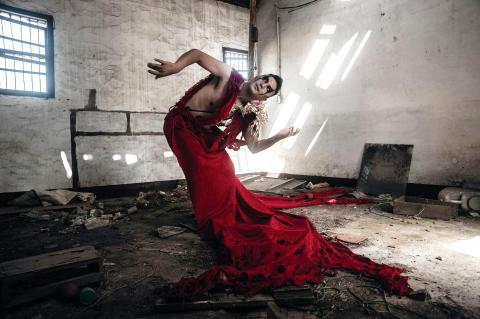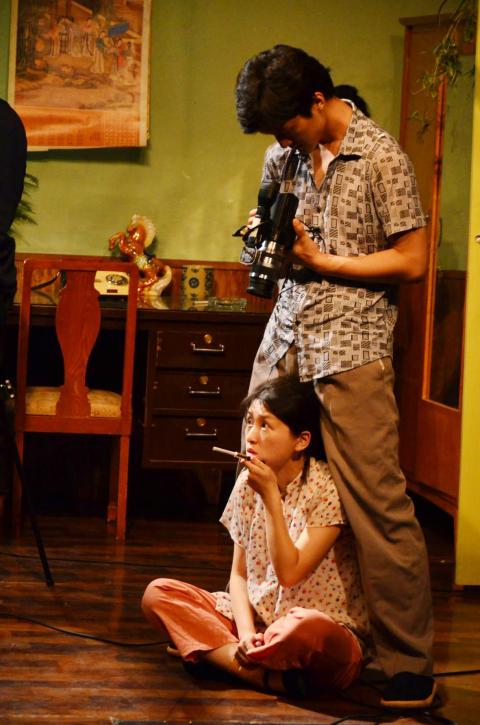The Taipei Arts Festival (TAF, 台北藝術節) celebrates its 15th birthday this year with a program of 11 shows, some already with an established reputation, others original works that will premiere at the festival. The Taipei Arts Festival is the smaller, cheekier, relation to the much grander, if younger, Taiwan International Festival of the Arts (台灣國際藝術節) that took place earlier this year, and it has very much its own attitude and ambition.
“Our budget is limited, and unlike many larger arts festivals, we are not really in a position to buy established [international] names,” Keng Yi-wei (耿一偉), artistic director for the festival said in a phone interview with the Taipei Times last week. “No one will have anything to say against bringing in such shows, but in fact all you are doing is transporting hit shows from London or Avignon to Taipei. This is not what the Taipei Arts Festival wants to do. We already have the Taiwan International Festival of the Arts, which is more like a standard arts festival, bringing over big names from overseas. The list of choices is limited, and so I particularly want to emphasize something different.”
Keng said that TAF has taken an active role in providing input for new works created by artists for the festival. “Half of our programs are works that are collaborations between Taiwan artists and foreign artists … Moreover our choices are more youth-oriented, and are perhaps more creative.”

Photo courtesy of TAF
As an example, Keng mentioned that this year is the 200th anniversary of Richard Wagner’s birth. “Many arts festivals around the world will put on a Wagner opera. We can’t begin to afford something like that, so instead we created something quite different.” Keng was referring to Big Bang Wagner, an eclectic work featuring French-born performance artist Anne Tismer, musician Moritz Gagern from Germany and writer Jade Chen (陳玉慧) from Taiwan. The work is described as “a groundbreaking performance combining an exhibition, performance and electronic music party,” in the publicity material. The ticket includes audience admission to the show’s after party.
This predisposition for putting a new spin on the classics can be seen also in Theatre du Reve Experimental’s Thunderstorm 2.0, a reworking of the modernist classic by Chinese playwright Cao Yu (曹禺). The performance group from Shanghai “is dedicated to refreshing the stagnant theater scene in Beijing,” and its members work to develop experimental theater in several different directions, such as political, physical, documentary, multimedia and cross-cultural theater. Thunderstorm 2.0 would have Cao Yu spinning in his grave, but that is pretty much the idea.
The festival also features acts that are emerging onto the mainstream, such as Timber! by Cirque Alfonse of Canada, an alternative act that has emerged from the far-reaching inspiration of Cirque du Soleil. Set against a background of a logging community in Quebec, the actors perform feats of strength and agility against a rollicking soundtrack of traditional music of Quebec using many self-made props. There is also Andre & Dorine by the Kulunka Theatre Company of Spain, a show of masked performers serving as full-sized puppets and dealing with the complex emotions of an elderly couple coping with the devastation of Alzheimer’s disease.

Photo courtesy of TAF
The trans-cultural spirit of TAF is probably best exemplified by Red Demon (赤鬼), a production by Ex-Theater Asia, a group founded by Indian director Chongtham Jayanta Meetei and the Taiwanese actress Lin Pei-ann (林浿安) and starring Fangnas Nayao Pacilailai, an Amis Aborigine from Taitung County and Miyuki Kamimura from Japan, among others.
Of the 11 works in this year’s show, seven follow the developmental direction set by last year’s festival, “international co-productions with Taipei at their core,” in which foreign artists are invited to develop shows with Taiwan artists, pushing artistic boundaries in new directions. The theme this year is “exploring new worlds.” Keng said that while the scope of new adventure is diminishing in the real world, art still has many unexplored regions to which artists could travel if they only dared.
Extensive English-language information about the festival and the shows can be found at the festival Web site eng.taipeifestival.org.tw. The festival opens August 1 and runs until Sept 8.

The canonical shot of an East Asian city is a night skyline studded with towering apartment and office buildings, bright with neon and plastic signage, a landscape of energy and modernity. Another classic image is the same city seen from above, in which identical apartment towers march across the city, spilling out over nearby geography, like stylized soldiers colonizing new territory in a board game. Densely populated dynamic conurbations of money, technological innovation and convenience, it is hard to see the cities of East Asia as what they truly are: necropolises. Why is this? The East Asian development model, with

June 16 to June 22 The following flyer appeared on the streets of Hsinchu on June 12, 1895: “Taipei has already fallen to the Japanese barbarians, who have brought great misery to our land and people. We heard that the Japanese occupiers will tax our gardens, our houses, our bodies, and even our chickens, dogs, cows and pigs. They wear their hair wild, carve their teeth, tattoo their foreheads, wear strange clothes and speak a strange language. How can we be ruled by such people?” Posted by civilian militia leader Wu Tang-hsing (吳湯興), it was a call to arms to retake

This is a deeply unsettling period in Taiwan. Uncertainties are everywhere while everyone waits for a small army of other shoes to drop on nearly every front. During challenging times, interesting political changes can happen, yet all three major political parties are beset with scandals, strife and self-inflicted wounds. As the ruling party, the Democratic Progressive Party (DPP) is held accountable for not only the challenges to the party, but also the nation. Taiwan is geopolitically and economically under threat. Domestically, the administration is under siege by the opposition-controlled legislature and growing discontent with what opponents characterize as arrogant, autocratic

Desperate dads meet in car parks to exchange packets; exhausted parents slip it into their kids’ drinks; families wait months for prescriptions buy it “off label.” But is it worth the risk? “The first time I gave him a gummy, I thought, ‘Oh my God, have I killed him?’ He just passed out in front of the TV. That never happens.” Jen remembers giving her son, David, six, melatonin to help him sleep. She got them from a friend, a pediatrician who gave them to her own child. “It was sort of hilarious. She had half a tub of gummies,